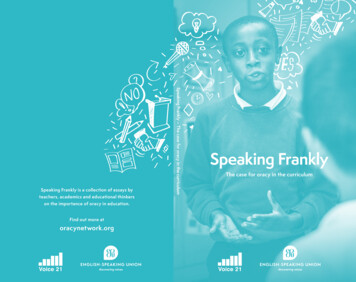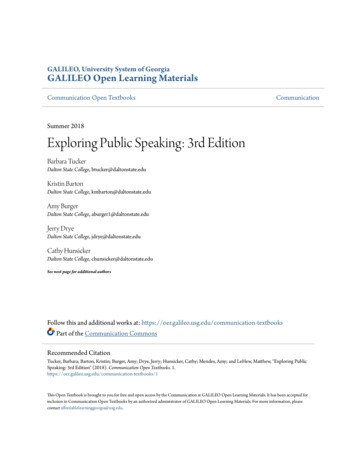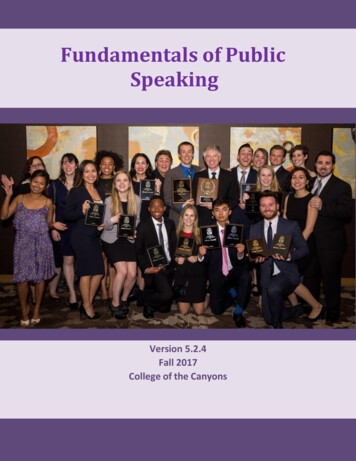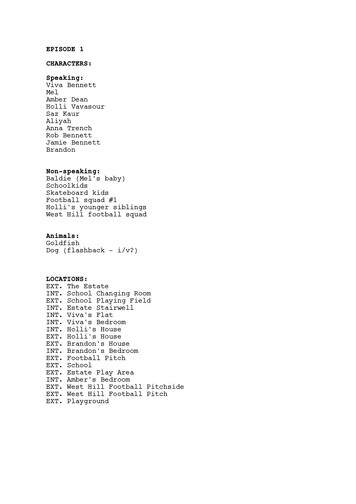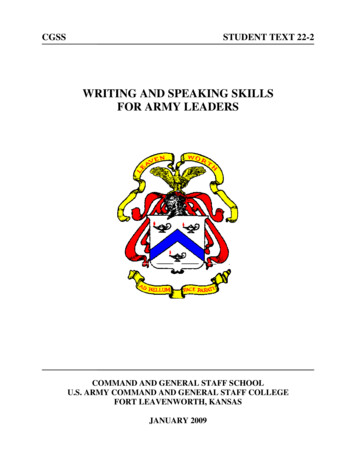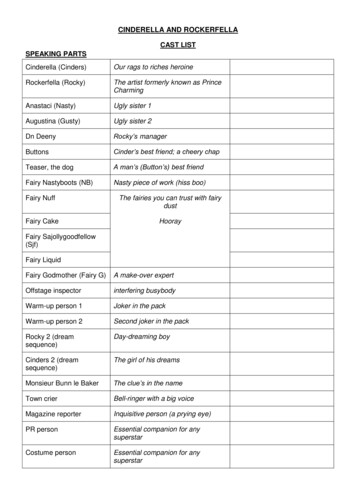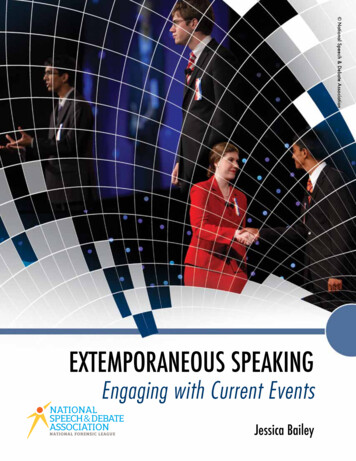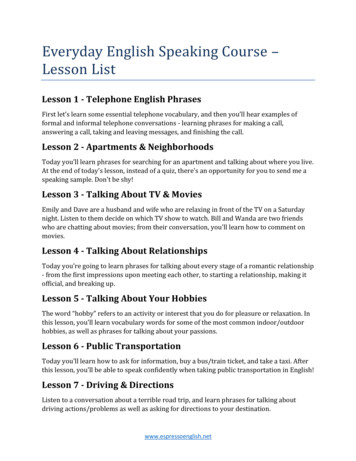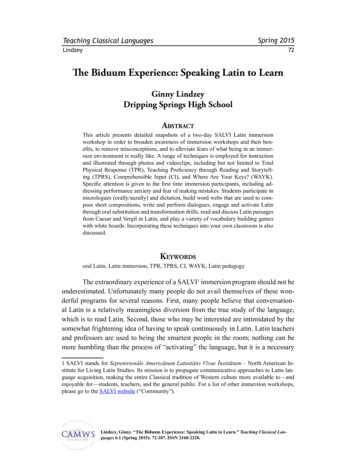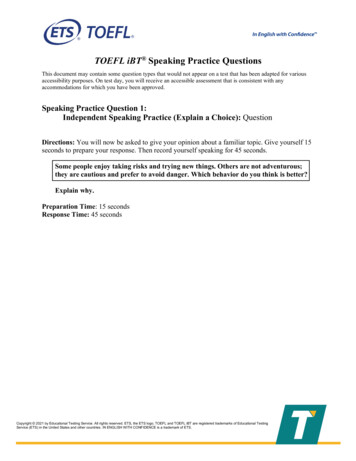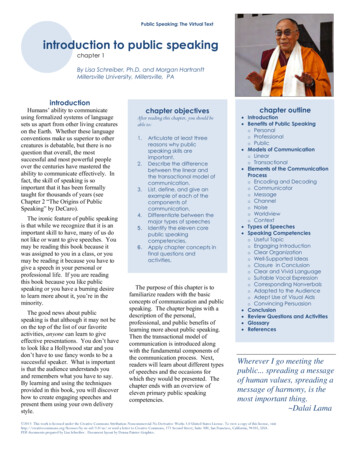
Transcription
Public Speaking: The Virtual Textintroduction to public speakingPublic Speaking: The Virtual Textchapter 1By Lisa Schreiber, Ph.D. and Morgan HartranftMillersville University, Millersville, PAintroductionHumans’ ability to communicateusing formalized systems of languagesets us apart from other living creatureson the Earth. Whether these languageconventions make us superior to othercreatures is debatable, but there is noquestion that overall, the mostsuccessful and most powerful peopleover the centuries have mastered theability to communicate effectively. Infact, the skill of speaking is soimportant that it has been formallytaught for thousands of years (seeChapter 2 “The Origins of PublicSpeaking” by DeCaro).The ironic feature of public speakingis that while we recognize that it is animportant skill to have, many of us donot like or want to give speeches. Youmay be reading this book because itwas assigned to you in a class, or youmay be reading it because you have togive a speech in your personal orprofessional life. If you are readingthis book because you like publicspeaking or you have a burning desireto learn more about it, you’re in theminority.The good news about publicspeaking is that although it may not beon the top of the list of our favoriteactivities, anyone can learn to giveeffective presentations. You don’t haveto look like a Hollywood star and youdon’t have to use fancy words to be asuccessful speaker. What is importantis that the audience understands youand remembers what you have to say.By learning and using the techniquesprovided in this book, you will discoverhow to create engaging speeches andpresent them using your own deliverystyle.chapter objectivesAfter reading this chapter, you should beable to:1.Articulate at least threereasons why publicspeaking skills areimportant.2. Describe the differencebetween the linear andthe transactional model ofcommunication.3. List, define, and give anexample of each of thecomponents ofcommunication.4. Differentiate between themajor types of speeches5. Identify the eleven corepublic speakingcompetencies.6. Apply chapter concepts infinal questions andactivities.The purpose of this chapter is tofamiliarize readers with the basicconcepts of communication and publicspeaking. The chapter begins with adescription of the personal,professional, and public benefits oflearning more about public speaking.Then the transactional model ofcommunication is introduced alongwith the fundamental components ofthe communication process. Next,readers will learn about different typesof speeches and the occasions forwhich they would be presented. Thechapter ends with an overview ofeleven primary public speakingcompetencies.chapter outline Introduction Benefits of Public Speakingo Personalo Professionalo Public Models of Communicationo Linearo Transactional Elements of the CommunicationProcesso Encoding and Decodingo Communicatoro Messageo Channelo Noiseo Worldviewo Context Types of Speeches Speaking Competencieso Useful Topico Engaging Introductiono Clear Organizationo Well-Supported Ideaso Closure in Conclusiono Clear and Vivid Languageo Suitable Vocal Expressiono Corresponding Nonverbalso Adapted to the Audienceo Adept Use of Visual Aidso Convincing Persuasion Conclusion Review Questions and Activities Glossary ReferencesWherever I go meeting thepublic. spreading a messageof human values, spreading amessage of harmony, is themost important thing. Dalai Lama 2013 This work is licensed under the Creative Commons Attribution-Noncommercial-No Derivative Works 3.0 United States License. To view a copy of this license, 3.0/us/ or send a letter to Creative Commons, 171 Second Street, Suite 300, San Francisco, California, 94105, USA.PDF documents prepared by Lisa Schreiber. Document layout by Donna Painter Graphics.
Chapter 1 Introduction to Public Speakingwww.publicspeakingproject.orgfulfill essential roles in our family andcommunity.Another great personal benefit ofpublic speaking is that it builds selfconfidence. It’s no surprise thatspeaking in public is scary, but byengaging in the activity you will buildself-confidence through the experience.Chapter 11, “Speaking withConfidence” by Grapsy ( in this book)will give you advice on how tominimize speech apprehension, and theadvice can be used in many other socialsituations as well.benefits of public speakingAccording to the Association ofAmerican Colleges and Universities,there are a core set of skills that arenecessary “both for a globally engageddemocracy and for a dynamicinnovation fueled economy” (Rhodes,2010, p. 10). In the category of“Intellectual and practical skills”public speaking is listed as one ofthese core skills. This is notparticularly surprising given thatcommunication skills are critical forintellectual development, careertrajectory, and civic engagement.Public speaking is universallyapplicable to all types of majors andoccupations and is seen by U.S.employers as a critical employabilityskill for job seekers (Rockler-Gladen,2009; U.S. Department of Labor,2000). No matter what your ambitionsand interests are, developing speakingskills will benefit your personal,professional, and public life.personalPeople don’t just give presentationson the job and in classes. At times weare called upon to give speeches in ourpersonal lives. It may be for a specialevent, such as a toast at a wedding. Wemay be asked to give a eulogy at afuneral for a friend or loved one. As apart of volunteer work, one may haveto introduce a guest speaker at an eventor present or accept an award forservice. Chapter 17, “Special OccasionSpeaking” by Scholl will help you toprepare for these brief but importantspeeches. Developing the skill to givethese types of speeches can help us toAction is a great restorer andbuilder of confidence.Inaction is not only the result,but the cause, of fear.Perhaps the action you takewill be successful; perhapsdifferent action oradjustments will have tofollow. But any action isbetter than no action at all. Norman Vincent PealeprofessionalTV announcers, teachers, lawyers,and entertainers must be able to speakwell, but most other professions requireor at the very least can benefit from theskills found in public speaking.It is believed 70% of jobs todayinvolve some form of public speaking(Aras, 2012). With the recenteconomic shift from manufacturing toservice careers, the ability tocommunicate with others has becomecrucial. Top CEOs advise that greatleaders must be able to communicateideas effectively, they must be able topersuade, build support, negotiate andspeak effectively in public (Farrell,2011). The chapters on “InformativeSpeaking” and “Persuasive Speaking”can help readers understand how towrite presentations that enhance theirleadership skills.But before you even start a career,you have to get a job. Effectivespeaking skills make you moreattractive to employers, enhancing yourchances of securing employment andlater advancing within your career.Employers, career counselors, and theNational Association of Colleges andEmployers (NACE) all list goodcommunication skills at the top of thelist of qualities sought in potentialemployees. According to NACE’sexecutive director, Marilyn Mackes, theJob Outlook 2013 Report found thatemployers are looking for people whocan communicate effectively (Koncz &Allen, 2012). Monster.com advises,“articulating thoughts clearly andconcisely will make a difference inboth a job interview and subsequent jobperformance” (McKay, 2005).publicLearning about public speaking willallow you to participate in democracyat its most basic level. Public speakingis important in creating and sustaining asociety, which includes informed,active participants. Even if you do notplan to run for office, learning aboutpublic speaking helps you to listenmore carefully to and critically evaluateother’s speeches. In fact the “ListeningEffectively” and “Critical Thinking andReasoning” chapters in this book byGoddu and Russ will help you todevelop those skills. Listening andcritical thinking allow you tounderstand public dilemmas, form anopinion about them, and participate inresolving them. The progress of thepast century involving segregation,1-2
Chapter 1 Introduction to Public Speakingwww.publicspeakingproject.orgwomen’s rights and environmentalprotection are the result of peopleadvancing new ideas and speaking outto others to persuade them to adoptchanges.models of communicationIt should be clear by now that publicspeaking happens all around us in manysegments of our lives. However, totruly understand what is happeningwithin these presentations, we need totake a step back and look at some of thekey components of the communicationprocess.linear model of communicationThe first theoretical model ofcommunication was proposed in 1949by Shannon and Weaver for BellLaboratories (Shannon & Weaver,1949). This three-part model wasintended to capture the radio andtelevision transmission process.However it was later adapted to humancommunication and is now known asthe linear model of communication.The first part of the model is thesender, and this is the person who isspeaking. The second part of the modelis the channel, which is the apparatusfor carrying the message (i.e., thephone or T.V.). The third part of themodel is the receiver, and this is theperson who picks up the message. Inthis model, communication is seen as aone-way process of transmitting amessage from one person to anotherperson. This model can be found inFigure 1.1.If you think about situations whenyou communicate with another personface-to-face or when you give a speech,you probably realize that this model isinadequate – communication is muchmore complicated than firing off amessage to others.He who would learn to flyone day must first learn tostand and walk and run andclimb and dance; one cannotfly into flying. Friedrich Nietzschetransactional model ofcommunicationModels of communication haveevolved significantly since Shannonand Weaver first proposed their wellknown conceptual model over sixtyyears ago. One of the most usefulmodels for understanding publicspeaking is Barnlund’s (2008)transactional model of communication.In the transactional model,communication is seen as an ongoing,circular process. We are constantlyaffecting and are affected by those wecommunicate with. The transactionalmodel has a number of interdependentprocesses and components, includingthe encoding and decoding processes,the communicator, the message, thechannel and noise. Although notdirectly addressed in Barnlund’s (2008)original transactional model,participants’ worldviews and thecontext also play an important role inthe communication process. See Figure1.2 on the next page for an illustration.elements of thecommunication processencoding and decodingEncoding refers to the process oftaking an idea or mental image,associating that image with words, andthen speaking those words in order toconvey a message. So, if you wantedto explain to your aunt the directions toyour new apartment, you would picturein your mind the landscape, streets andbuildings, and then you would selectthe best words that describe the routeso your aunt could find you.Decoding is the reverse process oflistening to words, thinking aboutthem, and turning those words intomental images. If your aunt weretrying to find her way to yourapartment, she would listen to yourwords, associate these words withstreets and landmarks that she knows,and then she would form a mental mapof the way to get to you. Ramsey’s“Using Language Well” (Chapter 10)provides additional insight into theencoding and decoding process.communicatorThe term communicator refers to allof the people in the interaction orspeech setting. It is used instead ofsender and receiver, because when weare communicating with other peoplewe are not only sending a message, weare receiving messages from otherssimultaneously. When we speak, weobserve others’ nonverbal behavior tosee if they understand us and we gaugetheir emotional state. The informationwe gain from these observations isknown as feedback. Over thetelephone, we listen to paralinguisticcues, such as pitch, tone, volume andfillers (i.e., “um,” “uh,” “er,” “like,”and so on). This means that1-3
Chapter 1 Introduction to Public Speakingcommunication is not a one-wayprocess. Even in a public speakingsituation, we watch and listen toaudience members’ responses. Ifaudience members are interested, agree,and understand us, they may leanforward in their seats, nod their heads,have positive or neutral facialexpressions, and provide favorablevocal cues (such as laughter, “That’sright,” “Uh huh,” or “Amen!”). Ifaudience members are bored, disagree,or are confused by our message, theymay be texting or looking away fromus, shake their heads, have unhappy orconfused expressions on their faces, orpresent oppositional vocal cues (likegroans, “I don’t think so,” “Thatdoesn’t make sense,” or “You’recrazy!”). Thus, communication isalways a transactional process – a giveand take of messages.www.publicspeakingproject.orgmessageThe message involves those verbaland nonverbal behaviors, enacted bycommunicators, that are interpretedwith meaning by others. The verbalportion of the message refers to thewords that we speak, while thenonverbal portion includes our tone ofvoice and other non-vocal componentssuch as personal appearance, posture,gestures and body movements, eyebehavior, the way we use space, andeven the way that we smell. Forinstance, the person who gets up tospeak wearing a nice suit will beinterpreted more positively than aperson giving the exact same speechwearing sweats and a graphic t-shirt.Or if a speaker tries to convince othersto donate to a charity that builds wellsin poor African villages using amonotone voice, she will not be aseffective as the speaker who gives thesame speech but speaks with a solemntone of voice. If there is ever a conflictbetween the verbal and the non-verbalaspects of a message, people willgenerally believe the nonverbal portionof the message. To test this, tightenyour muscles, clench your fists at yoursides, pull your eye brows together,purse your lips, and tell someone in aharsh voice, “NO, I’m NOT angry!”See if they believe your words or yournonverbal behavior.The message can also be intentionalor unintentional. When the message isintentional, this means that we have animage in our mind that we wish tocommunicate to an audience or aperson in a conversation, and we cansuccessfully convey the image from ourmind to others’ minds with relativeaccuracy. An unintentional message issent when the message that we wish toconvey is not the same as the message1-4
Chapter 1 Introduction to Public Speakingthe other person receives. Let’s sayyou are returning from an outing withyour significant other and she or heasks, “Did you have a good time?”You did have a good time but aredistracted by a T.V. commercial whenasked, so you reply in a neutral tone,“Sure, I had fun.” Your significantother may interpret your apathetic toneof voice and lack of eye contact tomean that you did not enjoy theevening, when in fact you actually did.Thus as communicators, we cannotalways be sure that the message wewish to communicate is interpreted aswe intended.channelThe channel is very simply themeans through which the messagetravels. In face-to-face communicationthe channel involves all of our senses,so the channel is what we see, hear,touch, smell and perhaps what we taste.When we're communicating withsomeone online, the channel is thecomputer; when texting the channel isthe cell phone; and when watching amovie on cable, the channel is the TV.The channel can have a profoundimpact on the way a message isinterpreted. Listening to a recording ofa speaker does not have the samepsychological impact as listening to thesame speech in person or watching thatwww.publicspeakingproject.orgperson on television. One famousexample of this is the 1960 televisedpresidential debate between John F.Kennedy and Richard Nixon.According to History.com (2012), oncamera, Nixon looked away from thecamera at the reporters asking himquestions, he was sweating and pale, hehad facial hair stubble, and he wore agrey suit that faded into the setbackground. “Chicago mayor RichardJ. Daley reportedly said [of Nixon],‘My God, they've embalmed himbefore he even died” (History.com,2012). Kennedy, on the other hand,looked into the camera, was tanned,wore a dark suit that made him standout from the background, and appearedto be calm after spending the entireweekend with aides practicing in ahotel room. Most of those wholistened to the radio broadcast of thedebate felt that it was a tie or thatNixon had won, while 70% of thosewatching the televised debate felt thatKennedy was the winner.first type of noise is physiologicalnoise, and this refers to bodilyprocesses and states that interfere witha message. For instance, if a speakerhas a headache or the flu, or if audiencemembers are hot or they're hungry,these conditions may interfere withmessage accuracy. The second type ofnoise is psychological noise.Psychological noise refers to mentalstates or emotional states that impedemessage transmission or reception. Forexample, if someone has just broken upwith a significant other, or if they'reworried about their grandmother who isin the hospital, or if they are thinkingabout their shopping list, this mayinterfere with communication processesas well. The third type of noise isactual physical noise, and this wouldbe simply the actual sound level in aroom. Loud music playing at a party, anumber of voices of people talkingexcitedly, a lawnmower right outsidethe window, or anything that is overlyloud will interfere with communication.The last type of noise is cultural noise.Cultural noise refers to messageinterference that results fromdifferences in peoples’ worldviews.Worldview is discussed in more detailbelow, but suffice it to say that thegreater the difference in worldview, themore difficult it is to understand oneanother and communicate effectively.worldviewMost people don’t give a lot ofthought to the communication process.In the majority of our interactions withothers, we are operating on automaticpilot. Although the encoding anddecoding process may appear to benoiseThe next aspect of the model ofcommunication is noise. Noise refersto anything that interferes withmessage transmission or reception(i.e., getting the image from yourhead into others’ heads). There areseveral different types of noise. The1-5
Chapter 1 Introduction to Public Speakingfairly straightforward, it is actuallymuch more complicated than it seems.The reason for this is because we allhave different worldviews. Worldviewis the overall framework through whichan individual sees, thinks about, andinterprets the world and interacts withit. There are five core components toour worldview.1. Epistemology is the way that weacquire knowledge and/or what countsas knowledge. Think about the processof conducting research. Thirty yearsago, to find a series of facts one had touse a card catalogue and scour thelibrary stacks for books. Nowresearchers can access thousands ofpages of information via their computerfrom the comfort of their own home.Epistemology is linked to publicspeaking because it governs audiencemembers’ preferred learning styles andwho or what they consider to becredible sources.2. Ontology refers to our beliefsystem, how we see the nature ofreality or what we see as true or false.We may (or may not) believe in aliensfrom outer space, that butter is bad foryou, that the Steelers will win theSuperbowl, or that humans will beextinct in 200 years. Speech writersshould be careful not to presume thataudience members share the samebeliefs. If a speaker claims that illnesscan be aided with prayer, but severalpeople in the audience are atheists, atbest the speaker has lost credibility andat worst these audience members couldbe offended.3. Axiology represents our valuesystem, or what we see as right orwrong, good or bad, and fair or unfair.www.publicspeakingproject.orgOne of the ways that you can tell whatpeople value is to ask them what theirgoals are, or to ask them what qualitiesthey look for in a life partner. Ourvalues represent the things that we hopefor --they do not represent reality.Values can have an impact on multiplelevels of the public speaking process,but in particular values impact speakercredibility and effectiveness inpersuasion. For instance, some culturesvalue modest dress in women, so afemale speaker wearing a sleevelessblouse while speaking could cause herto lose credibility with some audiencemembers. Or if audience membersvalue the freedom to bear arms over thebenefits of government regulation, aspeaker will have a difficult timeconvincing these audience members tovote for stricter gun control legislation.It is always good to explorethe stuff you don't agree with,to try and understand adifferent lifestyle or foreignworldview. I like to bechallenged in that way, andalways end up learningsomething I didn't know. Laura Linney4. Cosmology signifies the way thatwe see our relationship to the universeand to other people. Cosmologydictates our view of powerrelationships and may involve ourreligious or spiritual beliefs.Controversial speech topics (likeuniversal health care and the deathpenalty) are often related to this aspectof worldview as we must consider ourresponsibilities to other human beingsand our power to influence them.Interestingly, cosmology would alsoplay a role in such logistical points aswho is allowed to speak, the order ofspeakers on a schedule (e.g., from mostto least important), the amount of timea speaker has to speak, the seatingarrangement on the dais, and who getsthe front seats in the audience.5. Praxeology denotes our preferredmethod of completing everyday tasksor our approach to solving problems.Some speech writers may beginworking on their outlines as soon asthey know they will need to give aspeech, while others may wait until afew days before their speech to beginpreparing (we do not recommend thisapproach). Praxeology may also havean impact on a speaker’s preference ofdelivery style, methods of arrangingmain points, and choice of slideware(i.e., Power Point versus Prezi).It is important to understandworldview because it has a profoundimpact on the encoding and decodingprocess, and consequently on ourability to be understood by others. Trythis simple experiment. Ask two orthree people to silently imagine a dogwhile you imagine a dog at the sametime. “Dog” is a very concrete word(a word that describes a tangible objectthat can be perceived through thesenses), and it is one of the first wordschildren in the United States learn inschool. Wait a few seconds and thenask each person what type of dog theywere thinking of. Was it a Chihuahua?A greyhound? Golden retriever?Rottweiler? Or some other dog? Mostlikely each person you asked had adifferent image in his or her mind thanyou had in yours. This is our worldviewat work.To further illustrate, you may tell aco-worker, “I can’t wait to go homethis weekend – we are having lasagna!”Seems like a fairly clear-cut statement,1-6
Chapter 1 Introduction to Public Speakingwww.publicspeakingproject.orgassume your listener will understandyou. It takes hard work to makeyourself understood by an audience.Context is worth 80 IQpoints. Alan Kaycontextdoesn’t it? Unfortunately, it is not.While “lasagna” is also a concreteword, our worldviews cause us tointerpret each word in the statementdifferently. Where is “home?” Who ismaking the meal? What ingredientswill be used in the lasagna? Is this disheaten as a regular meal or for a specialoccasion? Will there be leftovers? Arefriends invited? Since everyone whohas eaten lasagna has had a differentexperience of the cuisine, we allacquire a different image in our mindwhen we hear the statement “ we arehaving lasagna!”Complicating matters is the fact thatthe more abstract the word becomes,the more room there is forinterpretation. Abstract words (wordsthat refer to ideas or concepts that areremoved from material reality) like“peace,” “love,” “immoral,” “justice,”“freedom,” “success,” and “honor” canhave a number of different meanings;each of which is predicated on one’sworldview. Communicators have theirown unique worldviews that shape boththe encoding and decoding processes,which means that we can never becompletely understood by anotherperson. People from the Midwest maycall carbonated beverages “pop,” whilethose from the east coast may say“soda,” and those from Georgia maysay “coke.” Even when simple termsare used like “oak tree” or “firehydrant,” each listener will form adifferent mental image when decodingthe message. Never takecommunication for granted, and neverThe last element of thecommunication process is the contextin which the speech or interaction takesplace. In the 1980’s context was taughtas the actual physical setting wherecommunication occurred, such as in aplace of worship, an apartment, aworkplace, a noisy restaurant, or agrocery store. People communicatedifferently in each one of these placesas there are unwritten rules ofcommunication (called norms) thatgovern these settings. More recentlythe concept of context has evolved andexpanded to include the type ofrelationships we have with others andthe communicative rules that governthose relationships. So you do notspeak the same way to your best friendas you do to a small child, your parent,your boss, your doctor or a policeofficer. And you may speak to yourbest friend differently in yourapartment than you do in your parents’home, and your communication mayalso change when you are both out withfriends on the weekend. In sum, thecontext refers to the norms that governcommunication in different situationsand relationships.types of speeches andspeaking occasionsThere are three general purposes forspeaking in public. The generalpurpose of a speech is usuallydetermined by the occasion in whichthe speech will be presented. The firstgeneral purpose is to inform youraudience. In an informative speech, thepresenter will share information about aparticular person, place, object,process, concept, or issue by defining,describing, or explaining. Occasionsfor which an informative speech wouldbe presented include a report presentedto coworkers, a teacher presentinginformation to his or her class, and atraining session for a job. The secondpurpose for public speaking is topersuade. In a persuasive speech, thepresenter will attempt to reinforce orchange their audiences’ beliefs,attitudes, feelings, or values. Severaloccasions where persuasion is usedinclude a sales pitch to potentialcustomers, a politician’s campaignspeech, or a debate during a publicforum. The last general purpose is tocommemorate or entertain. These typesof speeches often strengthen the bondsbetween audience members fromrecalling a shared experience or intendto amuse audiences through humor,stories, or illustrations. Examples ofthis purpose include a toast, such as abest man’s speech at a weddingreception; a eulogy to praise the dead; acommencement speech at graduation;or presenting an award. It is important1-7
Chapter 1 Introduction to Public Speakingto note that these general purposes mayoverlap one another. One might wish touse some forms of entertainment whileinforming or persuading his or heraudience.A desire presupposes thepossibility of action toachieve it; actionpresupposes a goal which isworth achieving. Ayn Randspeaking competenciesWe assume you are reading thisbook or chapter because you wish toimprove your speaking skills – aworthy goal. As Ayn Rand alludes toin her quote, a desire to succeed is thefirst step in achieving this objective.Nevertheless, you cannot hit a targetunless you know what it is. Thus, thefinal portion of this chapter is devotedto an overview of eleven speakingcompetencies which we consider to bethe standards for evaluating a variety ofpresentations at every level of mastery.These are based on the Public SpeakingCompetence Rubric [PSCR] (Schreiber,Paul & Shibley, 2012). A completecopy of the rubric can be found html.www.publicspeakingproject.org2. engaging introductionTo formulate an introduction thatorients the audience to the topic andthe speaker is the second speakingcompetency. An advanced speakerwrites an introduction that contains anexcellent attention-getter. She firmlyestablishes her credibility. Sheprovides a sound orientation to thetopic, states her thesis clearly, andpreviews her points in a cogent andmemorable way. For the beginningspeaker, her attention-getter ismundane and she somewhat developsher credibility. Her thesis isawkwardly composed and she provideslittle direction for the audience. Theineffective speaker has no openingtechnique, no credibility statement andprovides no background on the topic.In addition she has no thesis statementand no preview of her points.Don't leave inferences to bedrawn when evidence can bepresented. Richard Wright4. well-supported ideasFourth on the list of speakingcompetencies is to locate, synthesize,and employ compelling supportingmaterials. In the advanced speaker’sspeech, her key points are wellsupported with a variety of crediblematerials, and her sources provideexcellent support for her thesis. Inaddition, all of her sources are clearlycited. A beginning speaker has pointsthat are generally supported with a fairmix of materials. Only some of herevidence supports her thesis, and hersource citations need to be clarified.An ineffective speaker gives a speechwith no supporting materials or nosource citations.5. closure in conclusion1. useful topicThe first speaking competency is toselect a topic that is appropriate to theaudience and the occasion. Anadvanced speaker selects a worthwhiletopic that engages the audience. Histopic also presents the audience wit
introduction to public speaking chapter 1 By Lisa Schreiber, Ph.D. and Morgan Hartranft Public Speaking: The Virtual Text chapter objectives After reading this chapter, you should be able to: o 1. Articulate at least three reasons why public speaking skills are important. 2. Describe the dif
